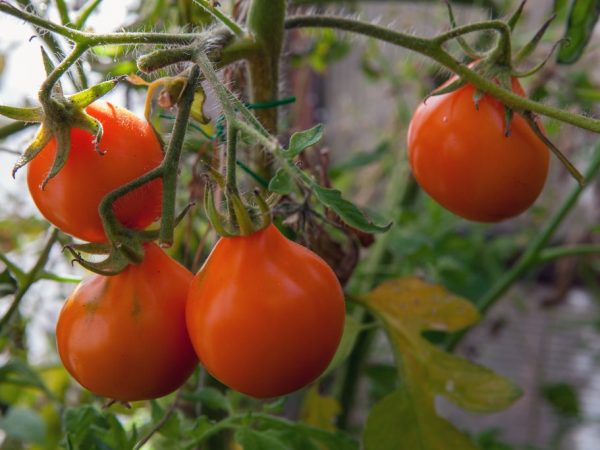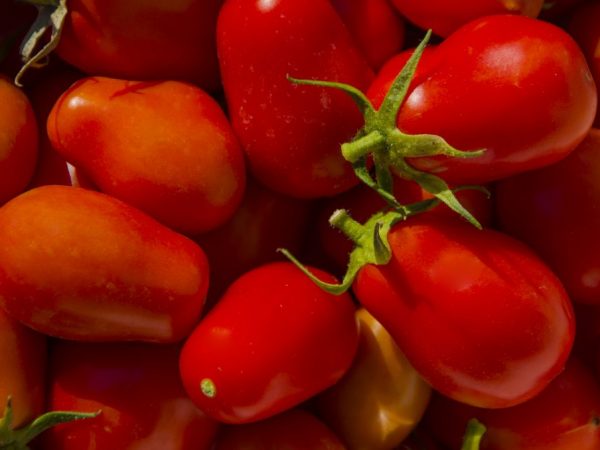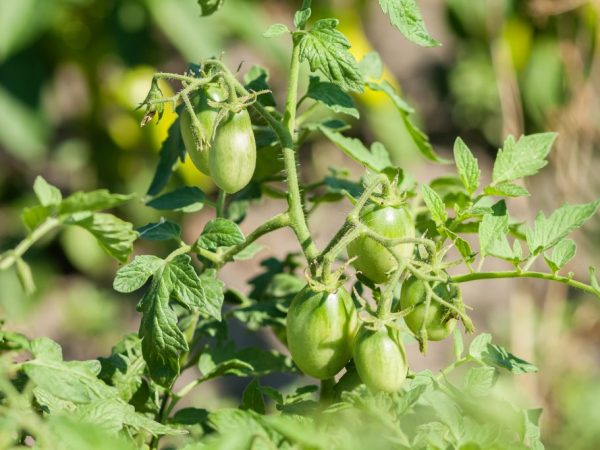Characteristics of tomato Japanese truffle
The Japanese truffle tomato is slowly but surely winning the tables of avid summer residents and experienced gardeners. To date, breeders have bred many different varieties. Looking at the photos of these "handsome men", it will be very difficult to walk past the counter with their seeds in the store. Universal fruits are often used for conservation. Tomatoes have a dense consistency, which allows them to be stored for a long time. The full characteristics and description of this variety will help novice farmers make the right choice.

Characteristics of tomato Japanese truffle
general review
The Japanese truffle tomato belongs to varieties that do not have an end point of growth, that is, they are terminate. Productivity and ripening rate are at an average level. Gardeners are most attracted by the unusual taste and unique look of the tomatoes themselves. Cultivation can be carried out both in the open field and in greenhouse conditions.
In any case, you will have to tie up the bushes, because even in an open area, their height reaches one and a half meters. The Japanese truffle tomato variety is available in several varieties. They differ in the color palette of the fruit, as well as in taste. Tomatoes are pear-shaped, and their average weight is about 120 g. According to the color palette, the following varieties are distinguished:
- red;
- yellow;
- Orange;
- pink;
- the black.
The characteristics of flavoring shades are different for all variations. However, almost all fruits are sweet with a sour note. Golden Japanese truffle has a deep sweet taste and is therefore very often consumed as a fruit rather than a vegetable. All types are perfectly stored and transported without significant losses, unlike other tomatoes. This feature makes them an excellent choice for commercial activities.
Detailed acquaintance with variations
Red truffle tomatoes have a rich red color with a brown tint. They taste sweet with a characteristic sourness of tomatoes, which makes them a popular option for rolling whole, as well as making all kinds of sauces and dressings. Red truffle has a number of distinctive characteristics, thanks to which it won the great sympathy of housewives, and therefore it is found more often than other truffle tomatoes in dachas and vegetable gardens.
The black Japanese truffle, contrary to its name, has a dark brown fruit. Avid gourmets say that its taste is significantly different from other varieties, it is more sophisticated. The black tomato is most commonly used for fresh consumption.
The pink truffle tomato has a sweet flavor. It is dense in consistency, perfect for winter blanks. Some people grow it as an ornamental plant. The golden tomato is distinguished not only by its sweet taste, thanks to which it can be consumed as a fruit, but also by the color of the fruit itself.They have a deep yellow color with a golden hue, and the weight of one fruit can reach 150 g.
The orange truffle has a rich orange hue. Tomatoes of this variety are also large in size, when ripe they can weigh 250 g. It is used both for fresh consumption and for rolling into jars for the winter.
Advantages and disadvantages

Fruits keep well
The description of the variety is still rarely found in popular publications of magazines for gardeners, but this does not reduce interest in it. The variety was bred back in 2000 in the Russian Federation. The reviews of those who have already tried and appreciated tomatoes are mostly favorable. Naturally, like other crops grown in gardens, the Japanese truffle tomato has its advantages and disadvantages. Benefits Feedback:
- high resistance to diseases;
- unpretentious care;
- unusual look and taste;
- the density of the fruits allows them to be stored in cool vegetable stores for 4 months;
- low susceptibility to mechanical damage allows the use of tomatoes for commercial activities.
Among the minuses, gardeners call the impossibility of making this tomato variety from tomatoes. In addition, the plant is too susceptible to sudden changes in temperature. The brush of the plant is not strong enough, therefore, the bushes often break under the weight of their own fruits.
To grow a Japanese truffle tomato of any variety in an open area, only the southern part of Russia is suitable, while in the middle lane they can only be planted in greenhouse buildings. In the northern regions, a pink truffle will not even withstand greenhouse maintenance.
How to grow
Like other types of tomatoes, Japanese truffles are sown in the ground, and in the future, the cultivation characteristics are divided into:
- seedling care;
- care for adult shrubs.
Before sowing, seeds should be treated against all sorts of pests and diseases, for which they are soaked in a solution of potassium permanganate or special chemicals are used for this, such as phytoverm and others. If you will be growing tomatoes on an open land, then the seeds should be sown in mid-March. Seedlings are planted in the ground at the end of May. If the tomato grows in a greenhouse, then the seeds are sown in February.
The seed mixture must be prepared in advance. It should include turf, humus and sand in proportions of 2: 2: 1. It is advisable to pre-fry the soil mixture in the oven in order to protect the plants in the future from infection with diseases and pests. The seeds are planted in the ground to a depth of 1 cm, and sprinkled on top with a small layer of soil.
Seedling care

The plant needs pinching
Seedling pots should be placed in a dark place and kept at a temperature of 16. When the crops have sprouted, they should be moved to a warmer place where more light penetrates. The temperature is raised to room temperature gradually. Plants begin to transplant into different containers when two leaves have already been formed on them. Before replanting a Japanese truffle to an open area, the ground should be prepared. It needs to be loosened and fertilized with minerals.
It is important to remember that transplanting to a new place, and especially from a pot to the ground, is always stressful for the plant, therefore, before the procedure, the plants begin to gradually harden so that they do not die from the temperature drop. The ideal soil temperature for planting a Japanese truffle tomato and pink and red and black would be 13.
Care for mature shrubs
Bushes are planted to a depth of 20 cm, in increments of 40 cm. Only viable seedlings are planted in the ground. Ideally, tomato beds should be prepared in the fall, so that at the time of planting there is a certain amount of nutrients in the ground that plants need to survive and give a good harvest in the future.
Due to the fact that the Japanese truffle does not have an end point of growth, and the bush can reach one and a half meters in height, the plant needs to be pinned. After transplanting into the ground, stepchildren - small leaves begin to germinate very quickly. They often merge with the trunk. They need to be removed to increase yields. The thing is that small leaves take too much juice and energy from the plant, and by removing them, you allow the plant to direct its forces to the growth of fruits.
Care
All plants, without exception, need regular watering. Tomatoes need to be watered almost every day, depending on the weather conditions. In wet weather, it is necessary to reduce the number of watering, in drought, water more often. Tomatoes are watered only with settled clean water heated in the sun. Water procedures should be carried out early in the morning, even before the sun rises high, or in the late evening, when it begins to set.
Periodically weed, loosen the soil and collect weeds. Due to the fact that the bushes grow too high, they are characterized by a quick twig, so it is recommended to immediately tie them to special supports. If the region in which you live is characterized by frequent temperature changes, the plants need to be covered with a special covering material or straw should be used for this. One of the important characteristics of caring for Japanese truffle tomatoes is timely and regular feeding with minerals.
What a plant can hurt
To be able to maintain and increase yields, you need to know everything about the diseases of your crops. The description of the variety says that tomatoes are highly resistant to many diseases, especially fungal ones. As the majority of people who cultivate the variety say, the plant does not really suffer from such diseases, but it is susceptible to phimosis.
It manifests itself as brown spots on plants with black masses of fungus inside. Such lesions should be removed immediately, and not only the leaves, stem, but also the fruit should be removed. In such cases, you can treat the branches and leaves with a fungicide, and also reduce the frequency of fertilizing with a high nitrogen content.
Occasionally, dry spotting occurs, which can appear on plants immediately after transplanting into open ground. Dry spots appear on the leaves, round in shape. After infection, the leaves quickly die off and begin to fall off. To preserve the plants, you can use the preparations of Consento, Tattu.


